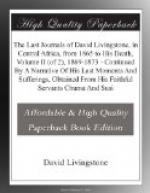All hands at the large canoe could move her only a few feet. Putting all their strength to her, she stopped at every haul with a jerk, as if in a bank of adhesive plaister. I measured the crown of a papyrus plant or palm, it was three feet across horizontally, its stalk eight feet in height. Hundreds of a large dark-grey hairy caterpillar have nearly cleared off the rushes in spots, and now live on each other. They can make only the smallest progress by swimming or rather wriggling in the water: their motion is that of a watch-spring thrown down, dilating and contracting.
9th April, 1873.—After two hours’ threading the very winding, deep channel of this southern branch of the Muanakazi, we came to where our land party had crossed it and gone on to Gandochite, a chief on the Lolotikila. My men were all done up, so I hired a man to call some of his friends to take the loads; but he was stopped by his relations in the way, saying, “You ought to have one of the traveller’s own people with you.” He returned, but did not tell us plainly or truly till this morning.
[The recent heavy exertions, coupled with constant exposure and extreme anxiety and annoyance, no doubt brought on the severe attack which is noticed, as we see in the words of the next few days.]
10th April, 1873.—The headman of the village explained, and we sent two of our men, who had a night’s rest with the turnagain fellow of yesterday. I am pale, bloodless, and; weak from bleeding profusely ever since the 31st of March last: an artery gives off a copious stream, and takes away my strength. Oh, how I long to be permitted by the Over Power to finish my work.
12th April, 1873.—Cross the Muanakazi. It is about 100 or 130 yards broad, and deep. Great loss of ai mua made me so weak I could hardly walk, but tottered along nearly two hours, and then lay down quite done. Cooked coffee—our last—and went on, but in an hour I was compelled to lie down. Very unwilling to be carried, but on being pressed I allowed the men to help me along by relays to Chinama, where there is much cultivation. We camped in a garden of dura.
13th April, 1873.—Found that we had slept on the right bank of the Lolotikila, a sluggish, marshy-looking river, very winding, but here going about south-west. The country is all so very flat that the rivers down here are of necessity tortuous. Fish and other food abundant, and the people civil and reasonable. They usually partake largely of the character of the chief, and this one, Gondochite, is polite. The sky is clearing, and the S.E. wind is the lower stratum now. It is the dry season well begun. Seventy-three inches is a higher rainfall than has been observed anywhere else, even in northern Manyuema; it was lower by inches than here far south on the watershed. In fact, this is the very heaviest rainfall known in these latitudes; between fifty and sixty is the maximum.




